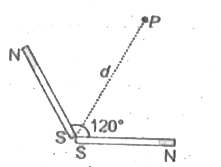Two identical magnets are placed perpendicular to each other with their unlike poles in contact. If each magnet has a magnetic moment 'M', what is the magnetic moment of the combination?
To solve the problem of finding the magnetic moment of two identical magnets placed perpendicular to each other with their unlike poles in contact, we can follow these steps:
Step 1: Understand the Configuration
We have two identical magnets, each with a magnetic moment M, placed perpendicular to each other. The unlike poles are in contact.
Step 2: Identify the Magnetic Moments
Let the magnetic moment of each magnet be represented as M. Since the magnets are placed at right angles to each other, we can denote their magnetic moments as vectors →M1 and →M2.
Step 3: Use the Vector Addition of Magnetic Moments
The total magnetic moment →Mtotal can be found using vector addition. Since the two magnetic moments are perpendicular, we can use the Pythagorean theorem to find the resultant magnetic moment.
Step 4: Apply the Pythagorean Theorem
The magnitude of the resultant magnetic moment can be calculated as:
Mtotal=√M2+M2
Step 5: Simplify the Expression
Now, we simplify the expression:
Mtotal=√2M2=M√2
Conclusion
Thus, the magnetic moment of the combination of the two magnets is:
M√2
---
We have two identical magnets, each with a magnetic moment M, placed perpendicular to each other. The unlike poles are in contact.
Let the magnetic moment of each magnet be represented as M. Since the magnets are placed at right angles to each other, we can denote their magnetic moments as vectors →M1 and →M2.
The total magnetic moment →Mtotal can be found using vector addition. Since the two magnetic moments are perpendicular, we can use the Pythagorean theorem to find the resultant magnetic moment.
The magnitude of the resultant magnetic moment can be calculated as:
Mtotal=√M2+M2
Now, we simplify the expression:
Mtotal=√2M2=M√2
Thus, the magnetic moment of the combination of the two magnets is:
M√2
Topper's Solved these Questions
- MAGNETISMBOOK - AAKASH SERIESCHAPTER - MAGNETISMEXERCISE - EXERCISE (LONG ANSWER QUESTIONS )
6 Videos
- MAGNETISMBOOK - AAKASH SERIESCHAPTER - MAGNETISMEXERCISE - EXERCISE (SHORT ANSWER QUESTIONS )
6 Videos
- LOGIC GATESBOOK - AAKASH SERIESCHAPTER - LOGIC GATESEXERCISE - Exercise (Very Short Answer)
10 Videos
- MOTION IN A PLANEBOOK - AAKASH SERIESCHAPTER - MOTION IN A PLANEEXERCISE - EXERCISE-3 (Circular Motion)
7 Videos
Similar Questions
The magnetic moment has dimensions of
View SolutionOne unpaired electron in an atom contributes a magnetic moment of 1.1 B.M. Calculate the magnetic moment of Cr
View SolutionA magnet of magnetic moment 10 Am2 has magnetic length 5 cm.The strength of magnet is
View SolutionTwo bar magnets are placed close to each other with their opposite poles facing each other. In absence of other forces, the magnets are pulled towards each other and their kinetc energy increases. Does it contradict our earlier knowledge that magnetic forces cannot do any work and hence cannot increase kinetic energy of a system?
View SolutionTwo identical thin bar magnets, each of length L and pole strength m are placed at right angles to each other, with the N pole of one touching the S-pole of the other. Find the magnetic moment of the system.
View SolutionA steel wire has a magmetic moment M. What will be its magnetic moment if it is bent into a semi-circular arc ?
View SolutionTwo magnets of moment M and 2 M are tied at an angle of 60∘ to each other . What is the resultant magnetic moment of the combination ?
View SolutionTwo identical short bar magnets are placed at 120∘ as shown in the figure. The magnetic moment of each magnet is M. Then the magnetic field at the point P on the angle bisector is given by

View SolutionA steel wire of length l has a magnetic moment M. It is bent into a semicircular arc. What is the new magnetic moment?
View SolutionA steel wire of length l has a magnetic moment M. It is bent into a semicircular arc. What is the new magnetic moment?
View Solution
